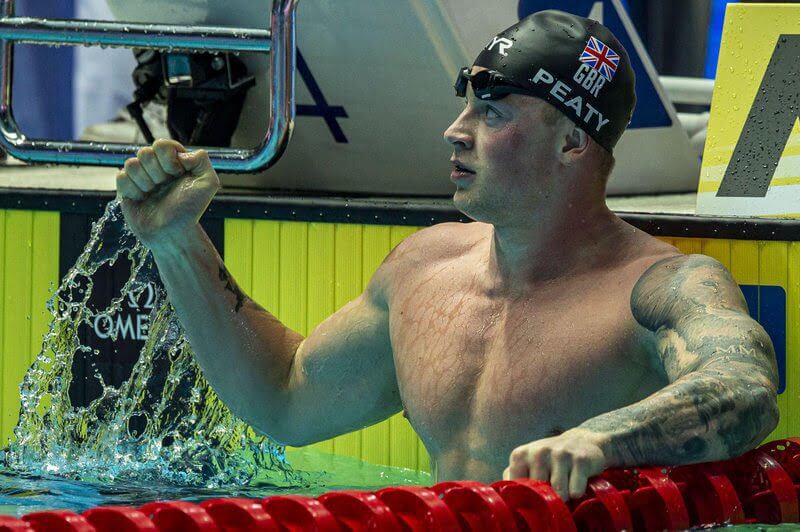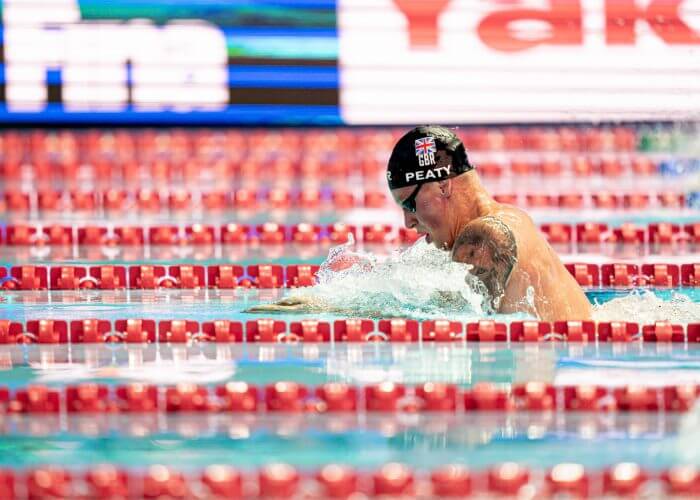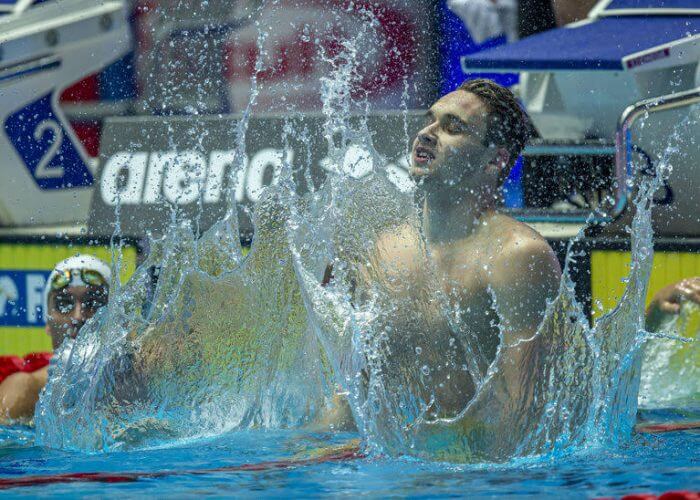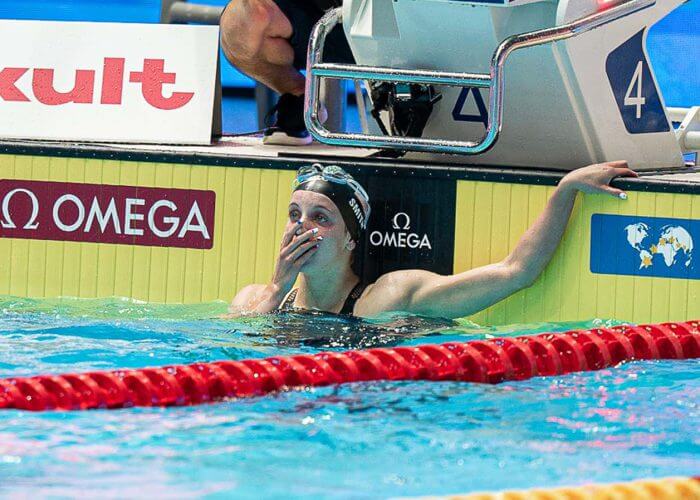Achievement of “Project 56” by Adam Peaty the Defining World Record in a Season of Historic Speed

Adam Peaty – “Project 56” Conquered
By their very nature, world-record performances are defining efforts that lend themselves to the history books. They will be remembered – in their moment – for changing the course of an event and providing a new barometer for all to chase. While each new standard is spectacular on its own, a hierarchy of world-record brilliance can be determined.
And that brings us to this exercise.
This final year of the decade was not short world-record swims, with two short-course marks established recently at the International Swimming League grand finale in Las Vegas. For the 2019 campaign, a total of 14 world records (individual and relay) were set, the breakdown featuring nine of the long-course variety and five in the short-course pool. So, which three shined above the others? Here is Swimming World’s look as the decade reaches for the wall.
Adam Peaty, Great Britain: 100 Breaststroke (56.88) – World Championships
In their search of continued greatness, there was a time when Adam Peaty and his longtime coach Mel Marshall sat down and developed a target for the future. Together, they mapped out “Project 56,” the nickname for the pursuit of the first sub-57-second performance in the history of the 100 breaststroke. Truthfully, they may as well have called their idea “Project Impossible.” Well, for everyone else.
Before examining what Peaty delivered at the World Championships in Gwangju, some context must be provided. A scan of the record books reveals that Peaty, the reigning Olympic champion, owns the 17-fastest performances in the history of the 100 breaststroke, and 19 of the 20-quickest efforts. On 13 occasions, the British star has cracked the 58-second barrier, something no other man in the event has managed. In fact, Peaty owns a 1.41-second margin over Belarus’ Ilya Shymanovich (58.29), the second-fastest performer the event has seen. Given that we’re discussing a two-lap event, that edge is downright difficult to digest.
The achievement of “Project 56” arrived in the semifinal round at the World Championships, where Peaty blistered his way to a clocking

Photo Courtesy: Becca Wyant
of 56.88, off an opening split of 26.63. The performance was pure elegance, a combination of power and grace, and the reward for Peaty and Marshall’s willingness to imagine such heights could be reached. A night later, he mined the gold medal in 57.14. Early in the decade, in 2011 in Shanghai to be precise, the world title was won in 58.71, the late Alexander Dale Oen of Norway the only athlete to break the 59-second barrier. Less than 10 years later, Peaty stands as an athlete competing in another stratosphere.
The next Olympic campaign is just around the corner, athletes around the globe drawing up blueprints for how they will prepare for the Tokyo Games and how they can finish atop the podium. How to catch Peaty, though, seems like an impossible task, the man knowing no rival except the digital readouts that flash onto the scoreboard.
“There’s no other word except for incredible,” Peaty said of his record-breaking performance in Gwangju. “Obviously, I’ve been chasing that for three years now. Ever since I touched that wall in Rio, I was like, ‘I could go faster.’”
He did, and history appreciates the belief.
Kristof Milak, Hungary: 200 Butterfly (1:50.73) – World Championships
Not since 2001 had there been the need for an eraser to the name column for the world record in the 200 butterfly. For 18-plus years, initiated by a special swim from a once-in-a-generation 15-year-old, the global standard in the event belonged to Michael Phelps. Between 2001 and 2009, Phelps set eight world records in the event that launched his career, his final world record of 1:51.51 produced at the 2009 World Championships in Rome.

Kristof Milak celebrates victory in Gwangju in world-record time. Photo Courtesy: Patrick B. Kraemer
A review of world-record lists typically sets a few aside as unlikely to go down and, for a while, Phelps’ mark from Rome – and at the height of the supersuit era – belonged in that category. Then Hungarian teenager Kristof Milak came around, armed with a confidence that he could be the one to supplant a legend as the fastest man in the 200 fly.
As Milak prepared for the final of the 200 butterfly at the World Championships, he was the undisputed favorite for the gold medal, having gone 1:52.96 in the semifinals, with no other competitors under 1:55. Still, Milak was easily more than a second shy of Phelps’ record, not exactly a fingernail at the finish. Yet, Milak knew there was much more to come, and he used the final for a showstopping performance.
Equal to Phelps’ world-record pace at the midway point of the final, Milak pushed himself on the third lap to move .36 ahead of Phelps’ 150-meter checkpoint. The question at the time was whether Milak could maintain his speed down the final length. The answer was provided through a roar, as the Hungarian generated a last-leg split of 29.16, compared to the 29.58 that Phelps unleashed on his final lap. The outcome for Milak was a world record of 1:50.73, a triumph by more than three seconds over Japan’s Daiya Seto and plaudits from the man whose mark he stole.
“As frustrated as I am to see that record go down, I couldn’t be happier to see how he did it,” Phelps told the New York Times. “That kid’s last 100 was incredible. He put together a great 200 fly from start to finish. It happened because there was a kid who wanted to do it, who dreamed of doing it, who figured out what it would take to do it, who worked on his technique until it was beautiful and who put in the really, really hard work that it takes to do it. My hat’s off to him.”
Regan Smith, United States: 200 Backstroke (2:03.35) – World Championships
The waiting game is never fun to play for athletes eager to burst into action and show their worth. At the World Championships, however, Regan Smith had no choice but to sit around and wait her turn to perform. It wasn’t until the sixth day of the eight-day competition that Smith received the opportunity to showcase her skills, but when she entered the water, she was nothing short of phenomenal.

Regan Smith reacts in shock to setting a world record in the 200 butterfly. Photo Courtesy: Becca Wyant
The latest in a long line of American teenagers who have been touted for stardom, Smith traveled to her second World Champs to solely contest the 200 backstroke. In what looked to be a wide-open event, Smith certainly was a medal contender. In a little more than two minutes of semifinal action, she let it be known that a world title – and more – were heading back to her home state of Minnesota.
Under world-record pace from the start of her semifinal of the 200 backstroke, Smith forced double-takes throughout the sport when she registered a time of 2:03.35 to break the seven-year-old world record of 2:04.06. The previous record was set by Missy Franklin en route to Olympic gold at the London Games in 2012. To back up her world record, Smith clocked the No. 2 time in history to earn gold, a 2:03.69 effort getting the job done.
“I’m in shock. I really don’t believe it. I didn’t think I’d ever do that. It’s crazy but I am very happy with what I was able to do,” Smith said of her world record. “I really just wanted to get myself in a good lane for the final and I was just hoping to slip under 2:06. That was my goal. If I (went) 2:05-mid or something, that would (have been) amazing. I exceeded my expectations and I’m super happy.”
What Smith pulled off in the 200 backstroke changed the dynamic of the rest of her meet, as the American coaching staff recognized there was no way of leaving her off the leadoff leg of the 400 medley relay on the final day of the World Champs. Given the opportunity to jumpstart that relay, Smith clocked 57.57 for the 100 backstroke, good for another world record, and joined Lilly King, Kelsi Dahlia and Simone Manuel for a global mark of 3:50.40 as a unit.
During the Olympic year, Smith will share the spotlight with the likes of Caeleb Dressel and Katie Ledecky as the faces of USA Swimming. It is an identity that is well earned for Smith, who is just beginning to show what she is capable of producing.



